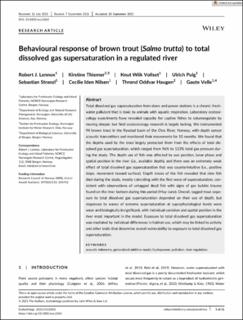| dc.contributor.author | Lennox, Robert J. | |
| dc.contributor.author | Thiemer, Kirstine | |
| dc.contributor.author | Vollset, Knut Wiik | |
| dc.contributor.author | Pulg, Ulrich | |
| dc.contributor.author | Stranzl, Sebastian | |
| dc.contributor.author | Nilsen, Cecilie Iden | |
| dc.contributor.author | Haugen, Thrond Oddvar | |
| dc.contributor.author | Velle, Gaute | |
| dc.date.accessioned | 2022-02-08T07:22:12Z | |
| dc.date.available | 2022-02-08T07:22:12Z | |
| dc.date.created | 2021-10-04T10:46:31Z | |
| dc.date.issued | 2022 | |
| dc.identifier.issn | 1936-0584 | |
| dc.identifier.uri | https://hdl.handle.net/11250/2977619 | |
| dc.description.abstract | Total dissolved gas supersaturation from dams and power stations is a chronic freshwater pollutant that is toxic to animals with aquatic respiration. Laboratory ecotoxicology experiments have revealed capacity for captive fishes to saturoregulate by moving deeper, but field ecotoxicology research is largely lacking. We instrumented 94 brown trout in the Rysstad basin of the Otra River, Norway, with depth sensor acoustic transmitters and monitored their movements for 10 months. We found that the depths used by the trout largely protected them from the effects of total dissolved gas supersaturation, which ranged from 96% to 133% total gas pressure during the study. The depth use of fish was affected by sun position, lunar phase and spatial position in the river (i.e., available depth), and there was an extremely weak effect of total dissolved gas supersaturation that was counterintuitive (i.e., positive slope, movement toward surface). Depth traces of the fish revealed that nine fish died during the study, mostly coinciding with the first wave of supersaturation, consistent with observations of untagged dead fish with signs of gas bubble trauma found on the river bottom during this period (May-June). Overall, tagged trout exposure to total dissolved gas supersaturation depended on their use of depth, but responses to waves of extreme supersaturation at supraphysiological levels were weak and biologically insignificant, with individual variation and spatial position in the river most important in the model. Exposure to total dissolved gas supersaturation was mediated by individual differences in habitat use, which may be linked to activity and other traits that determine overall vulnerability to exposure to total dissolved gas supersaturation. | en_US |
| dc.language.iso | eng | en_US |
| dc.publisher | Wiley | en_US |
| dc.rights | Navngivelse 4.0 Internasjonal | * |
| dc.rights.uri | http://creativecommons.org/licenses/by/4.0/deed.no | * |
| dc.title | Behavioural response of brown trout (Salmo trutta) to total dissolved gas supersaturation in a regulated river | en_US |
| dc.type | Journal article | en_US |
| dc.type | Peer reviewed | en_US |
| dc.description.version | publishedVersion | en_US |
| dc.rights.holder | Copyright 2021 The Authors | en_US |
| dc.source.articlenumber | e2363 | en_US |
| cristin.ispublished | true | |
| cristin.fulltext | original | |
| cristin.qualitycode | 1 | |
| dc.identifier.doi | 10.1002/eco.2363 | |
| dc.identifier.cristin | 1942935 | |
| dc.source.journal | Ecohydrology | en_US |
| dc.relation.project | Norges forskningsråd: 294742 | en_US |
| dc.relation.project | Norges forskningsråd: 297202 | en_US |
| dc.identifier.citation | Ecohydrology. 2022, 15 (1), e2363. | en_US |
| dc.source.volume | 15 | en_US |
| dc.source.issue | 1 | en_US |

